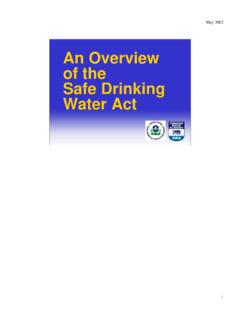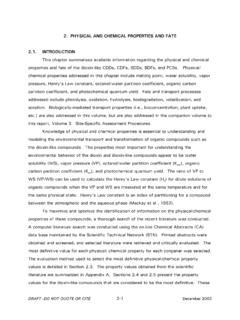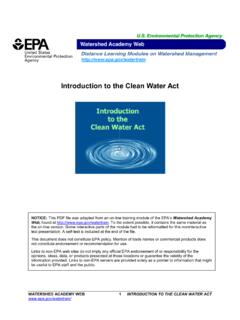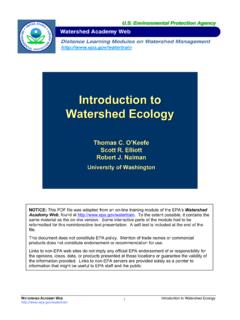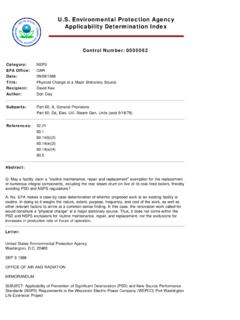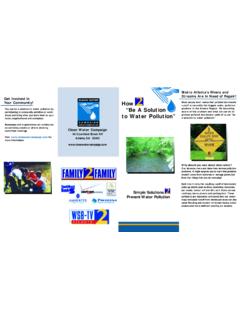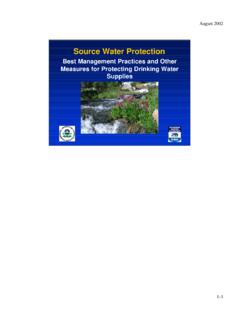Transcription of Introduction to the Underground Injection Control Program
1 January 2003. Introduction to the Underground Injection Control Program 1. January 2003. Drinking Water Academy Introductory modules Overview of the Safe Drinking Water Act Introduction to the EPA's Source Protection Programs Introduction to the Underground Injection Control Program Introduction to the Public Water Supply Supervision Program Regulatory modules Technical modules The Drinking Water Academy (DWA) develops and provides training to Federal, State and Tribal drinking water staff to help ensure that they will be adequately prepared to implement the provisions of the Safe Drinking Water Act (SDWA).
2 This training course is one of four introductory courses that introduce you to the Safe Drinking Water Act and its major programs: o Public water system supervision (PWSS);. o Source water protection; and o Underground Injection Control (UIC). In addition to these introductory courses, the DWA provides training on other drinking water topics: o SDWA regulations;. o Capacity development;. o Sanitary surveys;. o SDWIS; and o Technical courses on source water, UIC and public water system issues. The DWA also provides skills training on risk communication and training delivery.
3 For a complete list of the courses the DWA offers, visit our Web site at /gov/ 2. January 2003. Objectives Describe the foundation of the Underground Injection Control Program Describe the UIC Program framework Explain basic geology and Injection wells Explain some of the challenges facing today's UIC Program 3. January 2003. Objective 1. Describe the foundation of the Underground Injection Control (UIC). Program Historical uses of Injection wells Regulatory timeline Basic terminology EPA's mandate under SDWA. Mission of the UIC Program 4. January 2003. Early Injection 1930s: 1930s Oil companies began injecting wastes into depleted reservoirs through converted oil production wells 1950s: 1950s Injection of hazardous chemical and steel industry wastes began 1960s: 1960s Injection practices increase sharply as the manufacturing of chemicals boomed When oil is produced, some amount of salt water is also produced along with the oil.
4 The volume of associated salt water per barrel of oil ranges from a few ounces to 50 barrels (or more), and the salinity ranges from less than 10,000 to over 100,000 mg/L total dissolved solids (TDS). Disposal of this salt water has posed an environmental problem since oil was first produced in 1859. Prior to 1929, all salt water was discharged into surface water (ditches, creeks, and pits). In the 1930s, however, operators discovered that some of the salt water could be re- injected into the oil zone to maintain reservoir pressure and extend oil production. This was the first widespread use of Injection wells.
5 Most salt water, however, was still discharged into ditches, creeks, and pits. By the 1950s, landowners began to complain of salt water contamination of ground water resources. By the mid-1960s, State oil agencies were discovering that salt water discharges had contaminated many aquifers by seepage from the surface. In 1967, the Texas Oil and Gas Division banned the use of disposal pits for produced salt water, and specified Injection wells as the preferred disposal method. Most States followed soon after, and tens of thousands of salt water disposal wells were drilled.
6 Most oil companies also owned oil refineries, and by the late 1940s, a few refineries began to inject their liquid waste. Consumer demand for plastics and steel in the 1950s fueled a large expansion of those industries, and caused a search for a secure disposal method for the more- complex wastes that resulted from the new, more-sophisticated technologies. In 1950, there were only four industrial waste Injection wells, and a 1963 inventory listed only 30. By 1967, however, there were 110 industrial Injection wells operating, and when EPA took an initial look at the problem in 1974, they found that 322 wells had been drilled in Regions 2.
7 Through 9, of which 209 were operating. 5. January 2003. Cause for Concern 1968: 1968: Hammermill Paper Company's leak suspected to cause contamination five miles away 1975: 1975: Velsicol Chemical Company Injection well determined to have contaminated an Underground source of drinking water The awareness of the importance of ground water began with the expansion of population into the suburbs in the 1960s. The only water supply available in many new suburbs was ground water, but the increase in drilling activity revealed that many aquifers were already contaminated with salt water, due to surface disposal of oil wastes.
8 As a result, ground water pollution-related lawsuits became common in municipal and state courts, and the frequency of citizen complaints to state agencies and legislators increased tenfold, as measured in Texas, from 1955 to 1970. Responding to constituents' needs and complaints, State legislators began to create pollution-related water and ground water agencies by the mid-1960s, such as the Water Pollution Control Board in Texas. Since 80 percent of industria l Injection wells were located in Texas, by 1969 the Water Pollution Control Board had developed an Injection well regulatory Program , in addition to its counterpart in the Oil and Gas Division.
9 In addition to the regulatory attention caused by the increase in the use of Injection technology for industrial waste disposal, there were two high-profile pollution cases that attracted national headline attention. o An industrial waste Injection well at Hamermill Paper was improperly sited in an over-pressured Injection zone, and Injection pressure caused noxious waste to flow uncontrolled out of an abandoned borehole five miles away, destroying the Michigan Union War Veteran's Memorial Cemetary and polluting Lake Erie. o Another pollution incident involved a well at a Velsicol Chemical plant in Arkansas, which contaminated a USDW and caused health problems among residents.
10 6. January 2003. Regulatory Timeline States Early State actively programs involved to regulate in ground First ground water Federal UIC. water pollution regulations discharges issues CWA SDWA. 1930s 1960s 1972 1974 1980. The sequence of events leading to today's Underground Injection Control Program began with State programs. Although as early as the 1930s a few States had regulations conc erning discharges to ground water, the regulations were primarily concerned with communication with surface water or subsurface oil reservoirs. As noted above, the mid-1960s found State agencies actively involved with ground water pollution issues.
